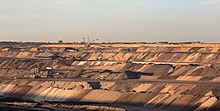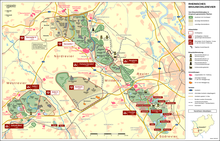The Tagebau Garzweiler (German pronunciation: [ˈtaːɡəbaʊ̯ ˈɡaʁt͜sˌʋaɪ̯lɐ]) is a surface mine (German: Tagebau) in the German state of North Rhine-Westphalia. It is operated by RWE and used for mining lignite.[1] The mine currently has a size of 48 km2 (19 sq mi) and got its name from the village of Garzweiler which previously existed at this location. The community was moved to a section of Jüchen with the same name.[2]
 Panoramic view of Tagebau Garzweiler | |
| Location | |
|---|---|
| Country | Germany |
| Coordinates | 51°03′15″N 6°30′35″E / 51.05417°N 6.50972°E |
| Production | |
| Products | Lignite |
| Owner | |
| Company | RWE |

The open-pit mine

The mine is located west of Grevenbroich and exploitation is progressing towards Erkelenz. Mining was originally limited to the 66 km2 (25 sq mi) Garzweiler I area located east of the A 44 motorway. Mining in the 48 km2 (19 sq mi) Garzweiler II area started in 2006 and it will take until around 2045 to fully exploit both sectors. The lignite is used for power generation at nearby power plants such as Neurath[3] and Niederaußem. In 2015 1500 protesters took part in civil disobedience against the mine on the basis that it is Europe’s biggest source of CO2 emissions. Around 1000 people entered the coal mine and all of the diggers in its pit were brought to a standstill.[4]
It is not yet known what effect the plan to phase out all coal-fired power plants in Germany by 2038 will have on the Garzweiler lignite mine system.[5]
Traffic
The A 44 and A 61 motorways that crossed the planned mine area were also affected. The A 44 was closed in 2005, dismantled in 2006 and traffic rerouted to the widened A 61 and A 46 motorways. In 2017, as the mine expanded to the west, the A 61 was closed with traffic diverted onto a stretch of newly built A 44 to the east of its original route.
Displacement of people
In the early 1980s, it is estimated that more than 30,000 people had to be moved for the Garzweiler mine.[6] These people had to leave their houses and move. Plans for Garzweiler II required that 12 more towns would have to be removed, with around 12,000 more people relocated. This has caused many controversies where people protested to save their homes.
See also
- Church of St. Lambertus, Immerath
- Berverath
- Keyenberg
- Lützerath
- Kuckum
- Oberwestrich
- Unterwestrich
- North–South industrial spur
- Schloss Paffendorf
- Straße der Energie ("Street of energy")
- Ende Gelände 2015
- Ende Gelände 2019
- Inden open pit mine
- Hambach open pit mine
- Rhenish lignite mining area
- List of lignite mines in Germany
- List of active mines in Germany
- Commission on Growth, Structural Change and Employment
References
External links





